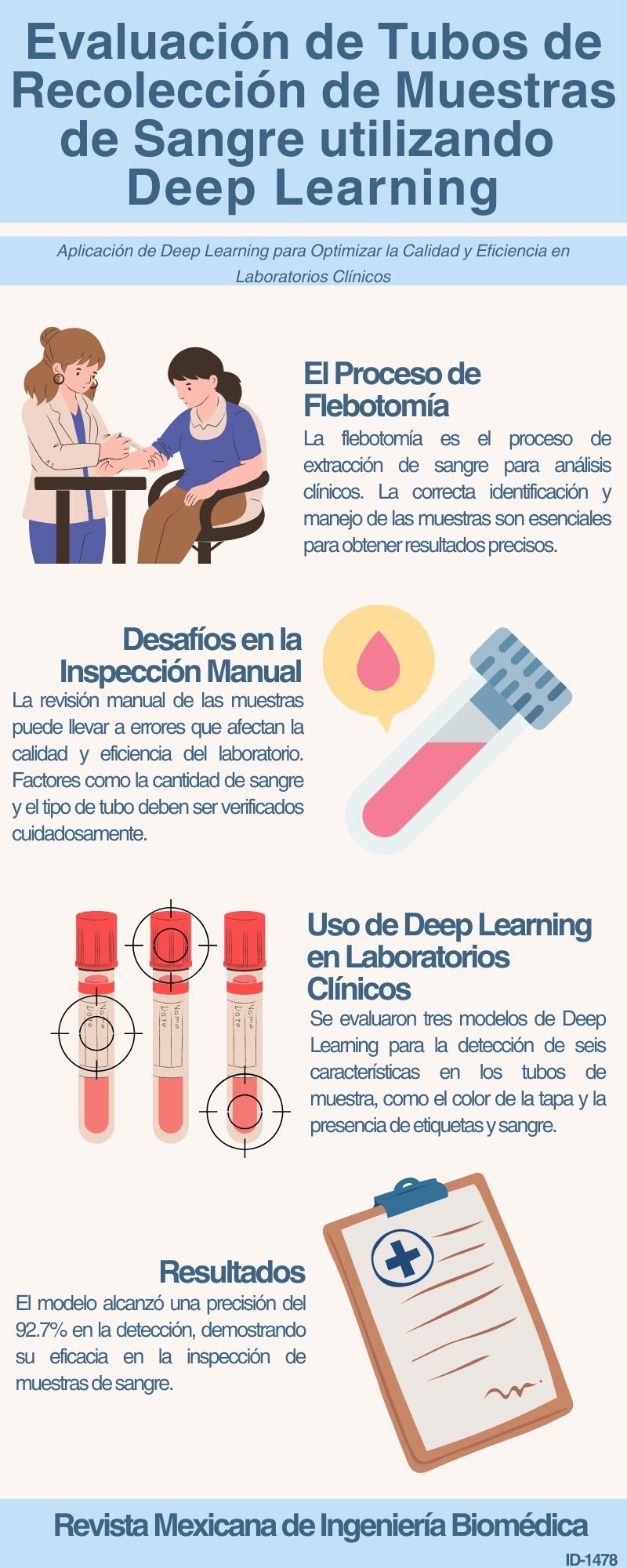Evaluación de Tubos de Recolección de Muestras de Sangre Utilizando Deep Learning
DOI:
https://doi.org/10.17488/RMIB.46.1.2Palabras clave:
deep learning, detección de objetos, laboratorio clínico, muestra de sangre, red neuronal convolucional, YOLOResumen
La flebotomía es un procedimiento para obtener muestras de sangre principalmente para análisis clínicos en laboratorios. La cantidad de sangre, identificación de tubos y el uso del tubo adecuado son características que el profesional de la salud inspecciona visualmente. Al ser una actividad manual, la posibilidad de error está presente pudiendo tener efectos tanto en la calidad, como en el flujo de trabajo y eficiencia. A pesar del avance de las tecnologías de la industria 4.0, incluida la inteligencia artificial (IA), hay poca evidencia de aplicaciones en laboratorios clínicos. Este estudio tiene como objetivo evaluar la idoneidad de utilizar el aprendizaje profundo o deep learning (DL) en la inspección de tubos con muestras de sangre. Particularmente se prueban tres arquitecturas YOLOv5, YOLOv7 y YOLOv8 en la detección de seis clases incluyendo color de tapa y presencia de etiqueta. El mayor desempeño de precisión se presentó con el modelo YOLOv8 obteniendo una precisión de 0.927 en la detección, lo que evidencia una alta capacidad para inspeccionar características importantes en el servicio de flebotomía, siendo DL una alternativa viable para asistir a los profesionales de la salud en actividades de inspección. Trabajo futuro incluye ampliar el número de imágenes de manera balanceada.
Descargas
Citas
R. Singh, A. Sharma, N. Sharma, R. Gupta, “Impact of Adam, Adadelta, SGD on CNN for White Blood Cell Classification,” en 2023 5th International Conference on Smart Systems and Inventive Technology (ICSSIT), Tirunelveli, India, 2023, pp. 1702-1709, doi: https://doi.org/10.1109/ICSSIT55814.2023.10061068
International Standard Organization, “ISO-15189 Medical laboratories–Requirements for quality and competence,” 2022. [Online]. Available: https://www.iso.org/standard/76677.html
G. Lima-Oliveira et al., “Laboratory Diagnostics and Quality of Blood Collection,” J. Med. Biochem., vol. 34, no. 3, pp. 288–294, 2015, doi: https://doi.org/10.2478/jomb-2014-0043
M. Plebani, “The detection and prevention of errors in laboratory medicine,” Ann. Clin. Biochem., vol. 47, no. 2, pp. 101–110, 2010, doi: https://doi.org/10.1258/acb.2009.009222
A. Aita, A. Padoan, G. Antonelli, L. Sciacovelli, M. Plebani, “Patient safety and risk management in medical laboratories: theory and practical application,” J. Lab. Precis. Med., vol. 2, no. 2, pp. 75–75, 2017, doi: https://doi.org/10.21037/jlpm.2017.08.14
J. H. Nichols, “Laboratory quality control based on risk management,” Ann. Saudi Med., vol. 31, no. 3, pp. 223–228, 2011, doi: https://doi.org/10.4103/0256-4947.81526
M. Plebani, “Exploring the iceberg of errors in laboratory medicine,” Clin. Chim. Acta, vol. 404, no. 1, pp. 16–23, 2009, doi: https://doi.org/10.1016/j.cca.2009.03.022
J. Hickner et al., “Testing process errors and their harms and consequences reported from family medicine practices: A study of the American Academy of Family Physicians National Research Network,” Qual Saf. Health Care, vol. 17, no. 3, pp. 194–200, 2008, doi: https://doi.org/10.1136/qshc.2006.021915
H. Javadifard et al., “Predicting Patient Waiting Time in Phlebotomy Units Using a Deep Learning Method,” en Proceedings - 2019 Innovations in Intelligent Systems and Applications Conference, ASYU 2019, Izmir, Turkey, 2019, pp. 1-4, doi: https://doi.org/10.1109/ASYU48272.2019.8946380
B. Fridath, A. Gildas, A. Dooguy, “White Blood Cells Recognition and Classification using Convolutional Neural Network,” en 2023 2nd International Conference on Applied Artificial Intelligence and Computing (ICAAIC), Salem, India, 2023, pp. 145-150, doi: https://doi.org/10.1109/ICAAIC56838.2023.10140293
J. Wang, “Deep Learning in Hematology: From Molecules to Patients,” Clin. Hematol. Int., vol. 6, no. 4, pp. 19-42, 2024, doi: https://doi.org/10.46989/001c.124131
R. Chandra, A. K. Geico, “Deep Learning Diagnostics: A Revolutionary Approach to Healthcare Insurance,” NeuroQuantology, vol. 19, no. 12, pp. 745-754, 2021, doi: https://doi.org/10.48047/nq.2021.19.12.NQ21278
H. Hou, R. Zhang, J. Li, “Artificial intelligence in the clinical laboratory,” Clin. Chim. Acta, vol. 559, 2024, art. no. 119724, doi: https://doi.org/10.1016/j.cca.2024.119724
D. Tlapa et al., “Effects of Lean Interventions Supported by Digital Technologies on Healthcare Services: A Systematic Review,” Int. J. Environ. Res. Public Health, vol. 19, no. 15, 2022, art. no. 9018, doi: https://doi.org/10.3390/ijerph19159018
G. L. Tortorella et al., “Effects of contingencies on healthcare 4.0 technologies adoption and barriers in emerging economies,” Technol. Forecast Soc. Change, vol. 156, 2020, art. no. 120048, doi: https://doi.org/10.1016/j.techfore.2020.120048
M. Ibrahim et al., “Augmentation in Healthcare: Augmented Biosignal Using Deep Learning and Tensor Representation,” J. Healthc Eng., vol. 2021, 2021, art. no. 6624764, doi: https://doi.org/10.1155/2021/6624764
E. Lee et al., “Transforming hospital emergency department workflow and patient care,” Interfaces, vol. 45, no. 1, pp. 58–82, 2015, doi: https://doi.org/10.1287/inte.2014.0788
G. Arcidiacono, A. Pieroni, “The revolution Lean Six Sigma 4.0,” Int. J. Adv. Sci. Eng. Inf. Technol., vol. 8, no. 1, pp. 141–149, 2018, doi: https://doi.org/10.18517/ijaseit.8.1.4593
J. De Mast et al., “Process improvement in healthcare: Overall resource efficiency,” Qual. Reliab. Eng. Int., vol. 27, no. 8, pp. 1095–1106, 2011, doi: https://doi.org/10.1002/qre.1198
D. Marshall et al., “Selecting a dynamic simulation modeling method for health care delivery research - Part 2: Report of the ISPOR dynamic simulation modeling emerging good practices task force,” Value Health, vol. 18, no. 2, pp. 147–160, 2015, doi: https://doi.org/10.1016/j.jval.2015.01.006
A. M. Ismael, A. Şengür, “Deep learning approaches for COVID-19 detection based on chest X-ray images,” Expert. Syst. Appl., vol. 164, 2021, art. no. 114054, doi: https://doi.org/10.1016/j.eswa.2020.114054
J. I. Arreola Minjarez et al., “Detection of COVID-19 Lung Lesions in Computed Tomography Images Using Deep Learning,” Rev. Mex. Ing. Biomed., vol. 43, no. 1, pp. 7–18, 2022, doi: https://doi.org/10.17488/RMIB.43.1.1
R. Indraswari et al., “Brain Tumor Detection on Magnetic Resonance Imaging (MRI) Images Using Convolutional Neural Network (CNN),” en 2022 9th International Conference on Electrical Engineering, Computer Science and Informatics (EECSI), Jakarta, Indonesia, 2022, pp. 367-373, doi: https://doi.org/10.23919/EECSI56542.2022.9946622
S. Guizani, N. Guizani, S. Gharsallaoui, “A Hybrid CNN-SVM Prediction Approach for Breast Cancer Ultrasound Imaging,” en 2023 International Wireless Communications and Mobile Computing( IWCMC), Marrakesh, Morocco, 2023, pp. 1574-1578, doi: https://doi.org/10.1109/iwcmc58020.2023.10182874
V. H. Benitez Baltazar et al., “Autonomic Face Mask Detection with Deep Learning: an IoT Application,” Rev. Mex. Ing. Biomed., vol. 42, no. 2, pp. 160–170, 2021, doi: https://doi.org/10.17488/RMIB.42.2.13
J. Fan, T. Huo, X. Li, “A review of one-stage detection algorithms in autonomous driving,” en 2020 4th CAA International Conference on Vehicular Control and Intelligence (CVCI), Hangzhou, China, 2020, pp. 210-214, doi: https://doi.org/10.1109/CVCI51460.2020.9338663
Q. Tang et al., “A Two-stage Raman Imaging Denoising Algorithm Based on Deep Learning,” en 2022 Asia Communications and Photonics Conference (ACP), Shenzhen, China, 2022, pp. 2096-2099, doi: https://doi.org/10.1109/ACP55869.2022.10088904
J. Redmon et al., “You only look once: Unified, real-time object detection,” en 2016 IEEE Conference on Computer Vision and Pattern Recognition (CVPR), Las Vegas, NV, USA, 2016, pp. 779-788, doi: https://doi.org/10.1109/CVPR.2016.91
S.-H. Chen et al., “A surface defect detection system for golden diamond pineapple based on CycleGAN and YOLOv4,” J. King Saud Univ. – Comput. Inf. Sci., vol. 34, no. 10, pp. 8041–8053, 2022, doi: https://doi.org/10.1016/j.jksuci.2022.07.018
J. M. Kimeu et al., “Deep learning-based mobile application for the enhancement of pneumonia medical imaging analysis: A case-study of West-Meru Hospital,” Inform. Med. Unlocked, vol. 50, 2024, art. no. 101582, doi: https://doi.org/10.1016/j.imu.2024.101582
S. Shahinfar, P. Meek, G. Falzon, “‘How many images do I need?’ Understanding how sample size per class affects deep learning model performance metrics for balanced designs in autonomous wildlife monitoring,” Ecol. Inform., vol. 57, 2020, art. no. 101085, doi: https://doi.org/10.1016/j.ecoinf.2020.101085
A. Cruz et al., “Detection of grapevine yellows symptoms in Vitis vinifera L. with artificial intelligence,” Comput. Electron. Agric., vol. 157, pp. 63–76, 2019, doi: https://doi.org/10.1016/j.compag.2018.12.028
D. E. Brown et al., “Neural network methods for diagnosing patient conditions from cardiopulmonary exercise testing data,” BioData Min., vol. 15, no. 1, 2022, art. no. 16, doi: https://doi.org/10.1186/s13040-022-00299-6
H. Wang, Q. Li, D. Zhang, D. Li, Q. Chen, “Key Components of Deep Metric Learning,” en 2022 2nd International Conference on Consumer Electronics and Computer Engineering (ICCECE), Guangzhou, China, 2022, pp. 648-651, doi: https://doi.org/10.1109/ICCECE54139.2022.9712771
V. Gonzalez-Huitron et al., “Disease detection in tomato leaves via CNN with lightweight architectures implemented in Raspberry Pi 4,” Comput. Electron. Agric., vol. 181, 2021, art. no. 105951, doi: https://doi.org/10.1016/j.compag.2020.105951
P. T. Q. Anh, D. Q. Thuyet, Y. Kobayashi, “Image classification of root-trimmed garlic using multi-label and multi-class classification with deep convolutional neural network,” Postharvest Biol. Technol., vol. 190, 2022, art. no. 111956, doi: https://doi.org/10.1016/j.postharvbio.2022.111956
M. Glučina et al., “Automated Detection and Classification of Returnable Packaging Based on YOLOV4 Algorithm,” Appl. Sci., vol. 12, no. 21, 2022, art. no. 11131, doi: https://doi.org/10.3390/app122111131
Y. Ke et al., “Empowering Intelligent Home Safety: Indoor Family Fall Detection with YOLOv5,” en 2023 IEEE Intl Conf on Dependable, Autonomic and Secure Computing, Intl Conf on Pervasive Intelligence and Computing, Intl Conf on Cloud and Big Data Computing, Intl Conf on Cyber Science and Technology Congress (DASC/PiCom/CBDCom/CyberSciTech), Abu Dhabi, United Arab Emirates, 2023, pp. 0942-0949, doi: https://doi.org/10.1109/DASC/PiCom/CBDCom/Cy59711.2023.10361490
G. P. Bhat, N. G. Cholli, “Effective object detection using Tensorflow facilitated YOLOv3 model,” en 2021 IEEE International Conference on Computation System and Information Technology for Sustainable Solutions (CSITSS), Bangalore, India, 2021, pp. 1-8, doi: https://doi.org/10.1109/CSITSS54238.2021.9683109
M. L. Francies, M. M. Ata, M. A. Mohamed, “A robust multiclass 3D object recognition based on modern YOLO deep learning algorithms,” Concurr. Comput. Pract. Exp., vol. 34, no. 1, 2022, art. no. e6517, doi: https://doi.org/10.1002/cpe.6517
R. Ammu, N. Sinha, “Small Segment Emphasized Performance Evaluation Metric for Medical Images,” en 2020 International Conference on Signal Processing and Communications (SPCOM), Bangalore, India, 2020, pp. 1-5, doi: https://doi.org/10.1109/SPCOM50965.2020.9179617
S. Raj, Y. Gupta, R. Malhotra, “License Plate Recognition System using Yolov5 and CNN,” en 2022 8th International Conference on Advanced Computing and Communication Systems, ICACCS, Coimbatore, India, 2022, pp. 372–377, doi: https://doi.org/10.1109/ICACCS54159.2022.9784966
S. W. Njoroge, J. H. Nichols, “Risk management in the clinical laboratory,” Ann. Lab. Med., vol. 34, no. 4, pp. 274-278, doi: https://doi.org/10.3343/alm.2014.34.4.274
R. K. Bania, “Ensemble of deep transfer learning models for real-time automatic detection of face mask,” Multimed. Tools Appl., vol. 82, no. 16, pp. 25131–25153, 2023, doi: https://doi.org/10.1007/s11042-023-14408-y
I. C. Juanatas, R. A. Juanatas, “Convolution Neural Network Approach for Facial Mask Detection,” en 2023 IEEE 12th Global Conference on Consumer Electronics (GCCE), Nara, Japan, 2023, pp. 1152-1155, doi: https://doi.org/10.1109/GCCE59613.2023.10315441
L. Kamal, R. J. R. Raj, “Harnessing deep learning for blood quality assurance through complete blood cell count detection,” e-Prime – Adv. Electr. Eng. Electron.Energy, vol. 7, 2024, art. no. 100450, doi: https://doi.org/10.1016/j.prime.2024.100450
P. Henderson, V. Ferrari, “End-to-end training of object class detectors for mean average precision,” en 13th Asian Conference on Computer Vision, Taipei, Taiwan, 2017, pp. 198–213, doi: https://doi.org/10.1007/978-3-319-54193-8_13
J. E. See, “Visual Inspection: A Review of the Literature,” Sandia National Laboratories, Albuquerque, New Mexico, Rep. no. SAND2012-8590, 2012. [Online]. Available: doi: https://www.osti.gov/servlets/purl/1055636
B. A. Graybeal et al., “Visual Inspection of Highway Bridges,” J. Nondestruct. Eval., vol. 21, pp. 67–83, 2002, doi: https://doi.org/10.1023/A:1022508121821
M. M. Stallard (Voelker), C. A. MacKenzie, F. E. Peters, “A probabilistic model to estimate visual inspection error for metalcastings given different training and judgment types, environmental and human factors, and percent of defects,” J. Manuf. Syst., vol. 48, pp. 97–106, 2018, doi: https://doi.org/10.1016/j.jmsy.2018.07.002
M. Plebani et al., “Quality indicators in laboratory medicine: A fundamental tool for quality and patient safety,” Clin. Biochem., vol. 46, no. 13–14, pp. 1170–1174, 2013, doi: https://doi.org/10.1016/j.clinbiochem.2012.11.028
L. Sciacovelli et al., “Quality Indicators in Laboratory Medicine: The status of the progress of IFCC Working Group ‘laboratory Errors and Patient Safety’ project,” Clin. Chem. Lab. Med., vol. 55, no. 3, pp. 348–357, 2017, doi: https://doi.org/10.1515/cclm-2016-0929
S. Shahangian, S. R. Snyder, “Laboratory medicine quality indicators: A review of the literature,” Am. J. Clin. Pathol., vol. 131, no. 3, pp. 418–431, 2009, doi: https://doi.org/10.1309/ajcpjf8ji4zldque
P. E. A. Kuriki, F. C. Kitamura, “Artificial Intelligence in Radiology: A Private Practice Perspective From a Large Health System in Latin America,” Semin. Roentgenol., vol. 58, no. 2, pp. 203–207, 2023, doi: https://doi.org/10.1053/j.ro.2023.01.006
R. Pandian, V. Vedanarayanan, D. N. S. Ravi Kumar, R. Rajakumar, “Detection and classification of lung cancer using CNN and Google net,” Meas.: Sens., vol. 24, 2022, art. no. 100588, doi: https://doi.org/10.1016/j.measen.2022.100588
I. Shahin, A. B. Nassif, M. B. Alsabek, “COVID-19 Electrocardiograms Classification using CNN Models,” en 14th International Conference on Developments in eSystems Engineering, DeSE 2021, Sharjah, Emiratos Árabes Unidos, 2021, pp. 448–452, doi: https://doi.org/10.1109/DESE54285.2021.9719358
H. J. Sandoval-Cuellar et al., “Image-based Glaucoma Classification Using Fundus Images and Deep Learning,” Rev. Mex. Ing. Biomed., vol. 42, no. 3, pp. 28–41, 2021, doi: https://doi.org/10.17488/RMIB.42.3.2
A. U. Haq et al., “MCNN: a multi-level CNN model for the classification of brain tumors in IoT-healthcare system,” J. Ambient. Intell. Humaniz. Comput., vol. 14, no. 5, pp. 4695-4706, 2022, doi: https://doi.org/10.1007/s12652-022-04373-z
R. Patgiri, V. Ajantha, S. Bhuvaneswari, V. Subramaniyaswamy, “Intelligent Defect Detection System in Pharmaceutical Blisters Using YOLOv7,” en 2024 Second International Conference on Emerging Trends in Information Technology and Engineering (ICETITE), Vellore, India, 2024, pp. 1-7, doi: https://doi.org/10.1109/ic-ETITE58242.2024.10493735
B. Wu, C. Pang, X. Zeng, X. Hu, “ME-YOLO: Improved YOLOv5 for Detecting Medical Personal Protective Equipment,” Appl. Sci., vol. 12, no. 23, 2022, art. no. 11978, doi: https://doi.org/10.3390/app122311978
Q. T. Do, J. Chaudri, “Creating Computer Vision Models for Respiratory Status Detection,” en 2022 44th Annual International Conference of the IEEE Engineering in Medicine & Biology Society (EMBC), Glasgow, Reino Unido, 2022, pp. 1350-1353, doi: https://doi.org/10.1109/EMBC48229.2022.9871978
D. Aguilar Bucheli et al., “Artificial Intelligence in Medical Education: Latin American context,” Metro Ciencia, vol. 31, no. 2, pp. 21-34, 2023, doi: https://doi.org/10.47464/MetroCiencia/vol31/2/2023/21-34
F. M. Delpino et al., “Emergency department use and Artificial Intelligence in Pelotas: design and baseline results,” Rev. Bras. Epidemiol., vol. 26, 2023, art. no. e230021, doi: https://doi.org/10.1590/1980-549720230021
R. Garcia Alonso, U. Thoene, D. Davila Benavides, “Digital Health and Artificial Intelligence: Advancing Healthcare Provision in Latin America,” IT Prof., vol. 24, no. 2, pp. 62–68, 2022, doi: https://doi.org/10.1109/MITP.2022.3143530
F. C. Kitamura et al., “Forging Connections in Latin America to Advance AI in Radiology,” Radiol. Artif. Intell., vol. 4, no. 5, 2022, art. no. e220125, doi: https://doi.org/10.1148/ryai.220125
M. Álvarez Vega, L. M. Quirós Mora, M. V. Cortés Badilla, “Inteligencia artificial y aprendizaje automático en medicina,” Rev. Med. Sinerg., vol. 5, no. 8, 2020, art. no. e557, doi: https://doi.org/10.31434/rms.v5i8.557
C. Fierro, J. Pérez, J. Mora, “Predicting Unplanned Readmissions with Highly Unstructured Data,” 2020, arXiv:2003.11622, doi: https://doi.org/10.48550/arXiv.2003.11622
M. Jamei et al., “Predicting all-cause risk of 30-day hospital readmission using artificial neural networks,” PLoS One, vol. 12, no. 7, 2017, art. no. e0181173, doi: https://doi.org/10.1371/journal.pone.0181173
F. Chang et al., “A mobile vision inspection system for tiny defect detection on smooth car-body surfaces based on deep ensemble learning,” Meas. Sci. Technol., vol. 30, no. 12, 2019, art. no. 125905, doi: https://doi.org/10.1088/1361-6501/ab1467
A. Rachman, R. M. C. Ratnayake, “Machine learning approach for risk-based inspection screening assessment,” Reliab. Eng. Syst. Saf., vol. 185, pp. 518–532, 2019, doi: https://doi.org/10.1016/j.ress.2019.02.008
J. Aust, D. Pons, “Comparative Analysis of Human Operators and Advanced Technologies in the Visual Inspection of Aero Engine Blades,” Appl. Sci., vol. 12, no. 4, 2022, art. no. 2250, doi: https://doi.org/10.3390/app12042250
O. Wosner, G. Farjon, A. Bar-Hillel, “Object detection in agricultural contexts: A multiple resolution benchmark and comparison to human,” Comput. Electron. Agric., vol. 189, 2021, art. no. 106404, doi: https://doi.org/10.1016/j.compag.2021.106404
T. Y. Kim et al., “A Deep Learning Technique for Optical Inspection of Color Contact Lenses,” Appl. Sci., vol. 13, no. 10, 2023, art. no. 5966, doi: https://doi.org/10.3390/app13105966
K. Y. Chan et al., “Ball bonding inspections using a conjoint framework with machine learning and human judgement,” Appl. Soft. Comput., vol. 102, 2021, art. no. 107115, doi: https://doi.org/10.1016/j.asoc.2021.107115
I. Rio-Torto et al., “Hybrid Quality Inspection for the Automotive Industry: Replacing the Paper-Based Conformity List through Semi-Supervised Object Detection and Simulated Data,” Appl. Sci., vol. 12, no. 11, 2022, art. no. 5687, doi: https://doi.org/10.3390/app12115687
M. S. Shaikh et al., “Performance evaluation of a coagulation laboratory using Sigma metrics,” Int. J. Health Care Qual. Assur., vol. 31, no. 6, pp. 600–608, 2018, doi: https://doi.org/10.1108/ijhcqa-07-2017-0134
M. Cheng et al., “MicroCrack-Net: A Deep Neural Network with Outline Profile-Guided Feature Augmentation and Attention-Based Multiscale Fusion for MicroCrack Detection of Tantalum Capacitors,” IEEE Trans. Aerosp. Electron. Syst., vol. 58, no. 6, pp. 5141–5152, 2022, doi: https://doi.org/10.1109/TAES.2022.3181117
S. Feng, H. Zhou, H. Dong, “Using deep neural network with small dataset to predict material defects,” Mater. Des., vol. 162, pp. 300–310, 2019, doi: https://doi.org/10.1016/j.matdes.2018.11.060
D. Wang, D. He, “Channel pruned YOLO V5s-based deep learning approach for rapid and accurate apple fruitlet detection before fruit thinning,” Biosyst. Eng., vol. 210, pp. 271–281, 2021, doi: https://doi.org/10.1016/j.biosystemseng.2021.08.015
R. Girshick, “Fast R-CNN,” en 2015 IEEE International Conference on Computer Vision (ICCV), Santiago, Chile, 2015, pp. 1440-1448, doi: https://doi.org/10.1109/ICCV.2015.169
S. Ren et al., “Faster R-CNN: Towards Real-Time Object Detection with Region Proposal Networks,” IEEE Trans. Pattern. Anal. Mach. Intell., vol. 39, no. 6, pp. 1137–1149, 2017, doi: https://doi.org/10.1109/TPAMI.2016.2577031
K. He et al., “Mask R-CNN,” en 2017 IEEE International Conference on Computer Vision (ICCV), Venecia, Italia, 2017, pp. 2980-2988, doi: https://doi.org/10.1109/ICCV.2017.322

Descargas
Publicado
Cómo citar
Número
Sección
Licencia
Derechos de autor 2025 Revista Mexicana de Ingenieria Biomedica

Esta obra está bajo una licencia internacional Creative Commons Atribución-NoComercial 4.0.
Una vez que el artículo es aceptado para su publicación en la RMIB, se les solicitará al autor principal o de correspondencia que revisen y firman las cartas de cesión de derechos correspondientes para llevar a cabo la autorización para la publicación del artículo. En dicho documento se autoriza a la RMIB a publicar, en cualquier medio sin limitaciones y sin ningún costo. Los autores pueden reutilizar partes del artículo en otros documentos y reproducir parte o la totalidad para su uso personal siempre que se haga referencia bibliográfica al RMIB. No obstante, todo tipo de publicación fuera de las publicaciones académicas del autor correspondiente o para otro tipo de trabajos derivados y publicados necesitaran de un permiso escrito de la RMIB.











